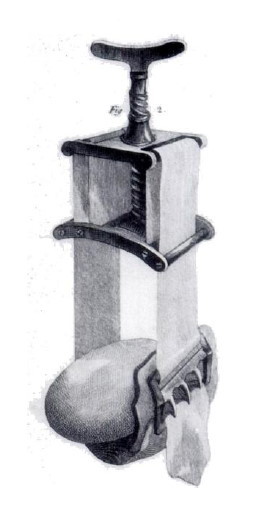Tourniquet
A tourniquet is a device that applies pressure to a limb or extremity in order to limit – but not stop – the flow of blood. It can be used in emergencies, surgery, or in post-operative rehabilitation. Tourniquets are widely used in both medical and military settings.
History[edit | edit source]
The use of tourniquets dates back to antiquity. They were used by the Romans and were described in the works of Galen. The modern tourniquet was developed in the 18th century.
In 1785, Sir Gilbert Blane introduced the use of the tourniquet in the British Navy, which significantly reduced the mortality rate from amputations.
Types of Tourniquets[edit | edit source]
Surgical Tourniquets[edit | edit source]
Surgical tourniquets are used to create a bloodless field during surgery. They are typically pneumatic devices that can be precisely controlled.
Emergency Tourniquets[edit | edit source]
Emergency tourniquets are used in trauma situations to control severe bleeding. They are often used in military settings and by emergency medical services.
Phlebotomy Tourniquets[edit | edit source]
Phlebotomy tourniquets are used to make veins more visible and easier to access during blood draws.
Mechanism of Action[edit | edit source]
Tourniquets work by applying circumferential pressure to a limb, which compresses the underlying tissues and blood vessels. This compression reduces blood flow to the area beyond the tourniquet.
Risks and Complications[edit | edit source]
While tourniquets are effective in controlling bleeding, they can also cause complications if used improperly. Prolonged use can lead to tissue damage, nerve injury, and compartment syndrome.
Modern Developments[edit | edit source]
Recent advancements in tourniquet technology include the development of limb protection sleeves and improved cuff designs to minimize complications.
Related Pages[edit | edit source]
Search WikiMD
Ad.Tired of being Overweight? Try W8MD's physician weight loss program.
Semaglutide (Ozempic / Wegovy and Tirzepatide (Mounjaro / Zepbound) available.
Advertise on WikiMD
|
WikiMD's Wellness Encyclopedia |
| Let Food Be Thy Medicine Medicine Thy Food - Hippocrates |
Translate this page: - East Asian
中文,
日本,
한국어,
South Asian
हिन्दी,
தமிழ்,
తెలుగు,
Urdu,
ಕನ್ನಡ,
Southeast Asian
Indonesian,
Vietnamese,
Thai,
မြန်မာဘာသာ,
বাংলা
European
español,
Deutsch,
français,
Greek,
português do Brasil,
polski,
română,
русский,
Nederlands,
norsk,
svenska,
suomi,
Italian
Middle Eastern & African
عربى,
Turkish,
Persian,
Hebrew,
Afrikaans,
isiZulu,
Kiswahili,
Other
Bulgarian,
Hungarian,
Czech,
Swedish,
മലയാളം,
मराठी,
ਪੰਜਾਬੀ,
ગુજરાતી,
Portuguese,
Ukrainian
Medical Disclaimer: WikiMD is not a substitute for professional medical advice. The information on WikiMD is provided as an information resource only, may be incorrect, outdated or misleading, and is not to be used or relied on for any diagnostic or treatment purposes. Please consult your health care provider before making any healthcare decisions or for guidance about a specific medical condition. WikiMD expressly disclaims responsibility, and shall have no liability, for any damages, loss, injury, or liability whatsoever suffered as a result of your reliance on the information contained in this site. By visiting this site you agree to the foregoing terms and conditions, which may from time to time be changed or supplemented by WikiMD. If you do not agree to the foregoing terms and conditions, you should not enter or use this site. See full disclaimer.
Credits:Most images are courtesy of Wikimedia commons, and templates, categories Wikipedia, licensed under CC BY SA or similar.
Contributors: Prab R. Tumpati, MD





